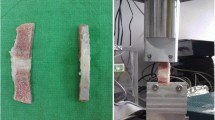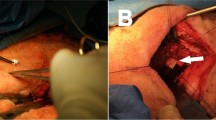Abstract
Purpose
Annulus fibrosus (AF) tissue engineering is gathering increasing interest for the development of strategies to reduce recurrent disc herniation (DH) rate and to increase the effectiveness of intervertebral disc regeneration strategies. This study evaluates the use of a bioactive microfibrous poly(l-lactide) scaffold releasing Transforming Growth Factor (TGF)-β1 (PLLA/TGF) for the repair and regeneration of damaged AF.
Methods
The scaffold was synthesized by electrospinning, with a direct incorporation of TGF-β1 into the polymeric solution, and characterized in terms of morphology and drug release profile. Biological evaluation was performed with bovine AF cells (AFCs) that were cultured on the scaffold up to 3 weeks to quantitatively assess glycosaminoglycans and total collagen production, using bare electrospun PLLA as a control. Histological evaluation was performed to determine the thickness of the deposited neo-ECM.
Results
Results demonstrated that AFCs cultured on PLLA/TGF deposited a significantly greater amount of glycosaminoglycans and total collagen than the control, with higher neo-ECM thickness.
Conclusions
PLLA/TGF scaffold induced an anabolic stimulus on AFCs, mimicking the ECM three-dimensional environment of AF tissue. This bioactive scaffold showed encouraging results that allow envisaging an application for AF tissue engineering strategies and AF repair after discectomy for the prevention of recurrent DH.






Similar content being viewed by others
References
Weber H (1994) The natural history of disc herniation and the influence of intervention. Spine (Phila Pa 1976) 19:2234–2238 (discussion 2233)
Moore AJ, Chilton JD, Uttley D (1994) Long-term results of microlumbar discectomy. Br J Neurosurg 8:319–326
Kambin P, Cohen LF, Brooks M, Schaffer JL (1995) Development of degenerative spondylosis of the lumbar spine after partial discectomy. Comparison of laminotomy, discectomy, and posterolateral discectomy. Spine (Phila Pa 1976) 20:599–607
Yorimitsu E, Chiba K, Toyama Y, Hirabayashi K (2001) Long-term outcomes of standard discectomy for lumbar disc herniation: a follow-up study of more than 10 years. Spine (Phila Pa 1976) 26:652–657
Suk KS, Lee HM, Moon SH, Kim NH (2001) Recurrent lumbar disc herniation: results of operative management. Spine (Phila Pa 1976) 26:672–676
Vucetic N, de Bri E, Svensson O (1997) Clinical history in lumbar disc herniation. A prospective study in 160 patients. Acta Orthop Scand 68:116–120
Alini M, Li W, Markovic P, Aebi M, Spiro RC, Roughley PJ (2003) The potential and limitations of a cell-seeded collagen/hyaluronan scaffold to engineer an intervertebral disc-like matrix. Spine (Phila Pa 1976) 28:446–454 discussion 453
Vadala G, Studer RK, Sowa G, Spiezia F, Iucu C, Denaro V, Gilbertson LG, Kang JD (2008) Coculture of bone marrow mesenchymal stem cells and nucleus pulposus cells modulate gene expression profile without cell fusion. Spine (Phila Pa 1976) 33:870–876
Hubert MG, Vadala G, Sowa G, Studer RK, Kang JD (2008) Gene therapy for the treatment of degenerative disk disease. J Am Acad Orthop Surg 6:312–319
Vadala G, Sobajima S, Lee JY, Huard J, Denaro V, Kang JD, Gilbertson LG (2008) In vitro interaction between muscle-derived stem cells and nucleus pulposus cells. Spine J 8:804–809
Spadaccio C, Rainer A, Trombetta M, Vadala G, Chello M, Covino E, Denaro V, Toyoda Y, Genovese JA (2009) Poly-l-lactic acid/hydroxyapatite electrospun nanocomposites induce chondrogenic differentiation of human MSC. Ann Biomed Eng 37:1376–1389
Bolgen N, Vargel I, Korkusuz P, Menceloglu YZ, Piskin E (2007) In vivo performance of antibiotic embedded electrospun PCL membranes for prevention of abdominal adhesions. J Biomed Mater Res B Appl Biomater 81:530–543
Xu X, Chen X, Xu X, Lu T, Wang X, Yang L, Jing X (2006) BCNU-loaded PEG-PLLA ultrafine fibers and their in vitro antitumor activity against Glioma C6 cells. J Control Release 114:307–316
Shao X, Hunter CJ (2007) Developing an alginate/chitosan hybrid fiber scaffold for annulus fibrosus cells. J Biomed Mater Res A 82:701–710
Mizuno H, Roy AK, Vacanti CA, Kojima K, Ueda M, Bonassar LJ (2004) Tissue-engineered composites of anulus fibrosus and nucleus pulposus for intervertebral disc replacement. Spine (Phila Pa 1976) 29:1290–1297 discussion 1297–1298
Gruber HE, Hoelscher G, Ingram JA, Hanley EN Jr (2009) Culture of human anulus fibrosus cells on polyamide nanofibers: extracellular matrix production. Spine (Phila Pa 1976) 34:4–9. doi:10.1097/BRS.0b013e31818f8c02
Nerurkar NL, Baker BM, Sen S, Wible EE, Elliott DM, Mauck RL (2009) Nanofibrous biologic laminates replicate the form and function of the annulus fibrosus. Nat Mater 8:986–992
Nerurkar NL, Elliott DM, Mauck RL (2007) Mechanics of oriented electrospun nanofibrous scaffolds for annulus fibrosus tissue engineering. J Orthop Res 25:1018–1028
Moon SH, Nishida K, Gilbertson LG, Lee HM, Kim H, Hall RA, Robbins PD, Kang JD (2008) Biologic response of human intervertebral disc cells to gene therapy cocktail. Spine (Phila Pa 1976) 33:1850–1855. doi:10.1097/BRS.0b013e31817e1cd7
Thompson JP, Oegema TR Jr, Bradford DS (1991) Stimulation of mature canine intervertebral disc by growth factors. Spine (Phila Pa 1976) 16:253–260
Bognitzki M, Czado W, Frese T, Schaper A, Hellwig M, Steinhart M, Greiner A, Wendorff JH (2001) Nanostructured fibers via electrospinning. Adv Mater 13:70–72
Dalby MJ, Gadegaard N, Tare R, Andar A, Riehle MO, Herzyk P, Wilkinson CD, Oreffo RO (2007) The control of human mesenchymal cell differentiation using nanoscale symmetry and disorder. Nat Mater 6:997–1003
Omlor GW, Bertram H, Kleinschmidt K, Fischer J, Brohm K, Guehring T, Anton M, Richter W (2010) Methods to monitor distribution and metabolic activity of mesenchymal stem cells following in vivo injection into nucleotomized porcine intervertebral discs. Eur Spine J 19:601–612
Vadala G, Sowa G, Hubert M, Gilbertson LG, Denaro V, Kang JD (2011) Mesenchymal stem cells injection in degenerated intervertebral disc: cell leakage may induce osteophyte formation. J Tissue Eng Regen Med. doi:10.1002/term.433
Maldonado BA, Oegema TR Jr (1992) Initial characterization of the metabolism of intervertebral disc cells encapsulated in microspheres. J Orthop Res 10:677–690
Sakai D, Mochida J, Iwashina T, Watanabe T, Nakai T, Ando K, Hotta T (2005) Differentiation of mesenchymal stem cells transplanted to a rabbit degenerative disc model: potential and limitations for stem cell therapy in disc regeneration. Spine 30:2379–2387
Sobajima S, Vadala G, Shimer A, Kim JS, Gilbertson LG, Kang JD (2008) Feasibility of a stem cell therapy for intervertebral disc degeneration. Spine J 8:888–896
Acknowledgments
The authors would like to gratefully acknowledge Dr. Franca Abbruzzese for her help in the cell viability analyses. The support of the Stem Cells Research Group of the Italian Society of Spine Surgery (GIS) and the Research Grant (PRIN2009) of the Italian Minister of Instruction, University and Research (MIUR) are gratefully acknowledged.
Conflict of interest
None.
Author information
Authors and Affiliations
Corresponding author
Rights and permissions
About this article
Cite this article
Vadalà, G., Mozetic, P., Rainer, A. et al. Bioactive electrospun scaffold for annulus fibrosus repair and regeneration. Eur Spine J 21 (Suppl 1), 20–26 (2012). https://doi.org/10.1007/s00586-012-2235-x
Received:
Accepted:
Published:
Issue Date:
DOI: https://doi.org/10.1007/s00586-012-2235-x




